
Illustration of the Transiting Exoplanet Survey Telescope (TESS) in front of a lava planet orbiting its host star. TESS will identify thousands of potential new planets for further study and observation. Credits: NASA GSFC
Final preparations are taking place in Florida for the April 16 launch of NASA's Transiting Exoplanet Survey Satellite (TESS), in search of undiscovered worlds around nearby stars, providing targets where future studies will assess their capacity to harbor life.
“One of the biggest questions in exoplanet exploration is: If an astronomer finds a planet in a star’s habitable zone, will it be interesting from a biologist's point of view?” said George Ricker, TESS principal investigator at the Massachusetts Institute of Technology (MIT) Kavli Institute for Astrophysics and Space Research in Cambridge, which is leading the mission. “We expect TESS will discover a number of planets whose atmospheric compositions, which hold potential clues to the presence of life, could be precisely measured by future observers.”
On March 15, the spacecraft passed a review that confirmed it was ready for launch. For final launch preparations, the spacecraft will be fueled and encapsulated within the payload fairing of its SpaceX Falcon 9 rocket.
TESS will launch from Space Launch Complex 40 at Cape Canaveral Air Force Station in Florida. With the help of a gravitational assist from the Moon, the spacecraft will settle into a 13.7-day orbit around Earth. Sixty days after launch, and following tests of its instruments, the satellite will begin its initial two-year mission.

Four wide-field cameras will give TESS a field-of-view that covers 85 percent of our entire sky. Within this vast visual perspective, the sky has been divided into 26 sectors that TESS will observe one by one. The first year of observations will map the 13 sectors encompassing the southern sky, and the second year will map the 13 sectors of the northern sky.
The spacecraft will be looking for a phenomenon known as a transit, where a planet passes in front of its star, causing a periodic and regular dip in the star’s brightness. NASA’s Kepler spacecraft used the same method to spot more than 2,600 confirmed exoplanets, most of them orbiting faint stars 300 to 3,000 light-years away
“We learned from Kepler that there are more planets than stars in our sky, and now TESS will open our eyes to the variety of planets around some of the closest stars,” said Paul Hertz, Astrophysics Division director at NASA Headquarters. “TESS will cast a wider net than ever before for enigmatic worlds whose properties can be probed by NASA’s upcoming James Webb Space Telescope and other missions.”

